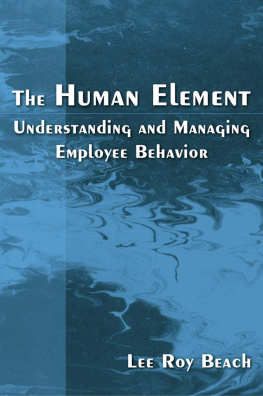THE HUMAN ELEMENT
First published 2007 by M.E. Sharpe
Published 2015 by Routledge
2 Park Square, Milton Park, Abingdon, Oxon OX14 4RN
711 Third Avenue, New York, NY 10017, USA
Routledge is an imprint of the Taylor & Francis Group, an informa business
Copyright 2007 Taylor & Francis. All rights reserved.
No part of this book may be reprinted or reproduced or utilised in any form or by any electronic, mechanical, or other means, now known or hereafter invented, including photocopying and recording, or in any information storage or retrieval system, without permission in writing from the publishers.
Notices
No responsibility is assumed by the publisher for any injury and/or damage to persons or property as a matter of products liability, negligence or otherwise, or from any use of operation of any methods, products, instructions or ideas contained in the material herein.
Practitioners and researchers must always rely on their own experience and knowledge in evaluating and using any information, methods, compounds, or experiments described herein. In using such information or methods they should be mindful of their own safety and the safety of others, including parties for whom they have a professional responsibility.
Product or corporate names may be trademarks or registered trademarks, and are used only for identification and explanation without intent to infringe.
Library of Congress Cataloging-in-Publication Data
Beach, Lee Roy.
The human element : understanding and managing employee behavior /
by Lee Roy Beach.
p. cm.
Includes bibliographical references and index.
ISBN: 978-0-7656-2035-4 (cloth: alk. paper)ISBN: 978-0-7656-2036-1 (cloth: alk. paper)
1. Organizational behaviorManagement. 2. Supervision of employees. 3. Problem solving. I. Title. II. Title: Understanding and managing employee behavior.
| HD58.7.B412 2007 |
658.4dc22 | 2006038941 |
ISBN 13: 9780765620361 (pbk)
ISBN 13: 9780765620354 (hbk)
To Byron Bissell, Margie Barber, and Barbara Beach,
from whom I have learned so much, with special thanks to
Linda Miller and James Wise for their help and good advice.
Contents
This book is for managers (and those about to become managers) who find themselves stressed and confused about how to deal with their employees.
With the possible exception of the military, which is a rather special world, it is common practice in modern organizations of all kinds to assign responsibility for employee management to people who have no idea how to do it. Even business school graduates find themselves overwhelmed despite having taken courses in human resources and, perhaps, supervision. This is largely because their courses focused more on legal and policy issues than on the day-to-day people problems that keep managers awake at night. Dont misunderstand meknowing about legal and policy issues is crucial, it just isnt enough.
I wrote this book to supplement the important things that are taught in human resource and supervision courses. I am a psychologist by training, but I have been a professor and an administrator in a business school for a number of years, and I have done a good deal of research and consulting in a variety of organizations. The purpose of education is to pass on what one has learned through experience and mistakes, so those who follow dont have to start from scratch and can avoid the mistakes. This book is my way of passing on what I have learned.
THE HUMAN EEMENT
Whatever the termmy boss, my supervisor, my managernearly everyone in every organization reports to somebody who oversees their job performance. The CEO reports to the board of directors, the division heads report to the CEO, an administrative assistant reports to a division head, an office staff reports to an office manager, team members report to a team leader, assembly line workers report to a foreman. For convenience, we will refer to all of the people to whom others report as managers, no matter what their job title may be, and we will refer to the people who report to them as their employees.
Most managers are reasonably intelligent, generally well intended, appropriately self-confident, and technically competent, or they wouldnt be managers in the first place. However, even the most successful managers admit to great uneasiness when it comes to dealing with their employees expectations, behavior, emotions, and performance problems. Over the course of our careers, most of us have lost more hours of sleep over issues related to our employees than over any other aspect of our jobs.
In contrast to the strategic and administrative aspects of managers jobs, employee management focuses on individual workers, making sure that they have the resources, skills, and guidance they need to meet their own and the organizations expectations. Because the organizations overall effort is made up of the combined efforts of all of its employees, the quality of that overall effort depends upon good employee management to ensure that each workers contribution is the best it can be.
Good employee management is not solely about efficiency and productivity. Every managers job also includes a responsibility to work with individual employees to establish mutual expectations about their respective responsibilities and how they each will behave toward the other in order to create an atmosphere that both enhances performance and builds commitment to theorganization. Indeed, management of expectations is the key to successfulemployee management because expectations are the standards against whichthey, and you, judge everything that happens. When expectations are met, allis well. When expectations are not met, trouble ensues. Most managementproblems involving employees stem from conflicting expectations or fromfailures on the part of either the employees or their manager to meet theothers expectations.
Although employee management occurs at every level of the organization, surprisingly few people actually are taught how to do it. Most trainingprograms are after-the-fact, remedial, and focus on specific problems, suchas morale or interpersonal conflict. Moreover, most fail to recognize thecentrality of expectation management to successful employee management. As a result, otherwise capable people find themselves thrust into employeemanagement without a clue about what to do. Some find they have a naturaltalent for it and simply get on with the job. Some get good advice and learnfast enough to survivebut with sleepless nights. The rest flounder arounduntil they develop some kind of expedient that reduces their anxiety whileproducing the illusion that they know what theyre doing.
Some Expedients That Look Like Employee Management, But Arent
Over the years, I have observed both good and bad employee managers andtried to figure out what makes them different. The bulk of this book is aboutwhat the good ones do. But, before we go there, lets look at some of theexpedients the bad ones have adopted to cover up the fact that they dontknow what theyre doing. Im sure Ive missed a few, but these are some ofthe expedients that Ive observed, repeatedly, and the problems that Ive seenarise from their use.
Laissez-faire
As you know, laissez-faire means (roughly) let them do as they will. As anexpedient, the manager tries to be hands off, and let the employees get onwith things. This sounds admirably democratic, trusting, and empowering, butit works only when the employees really know their jobs, are exceptionallymotivated and self-directed, and have unhindered access to information aboutwhat is wanted of them and why. Moreover, it assumes that their expectationsabout their performance coincide with managements, which is unlikely iftheir manager makes no effort to ensure that it happens.








